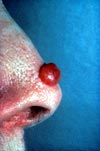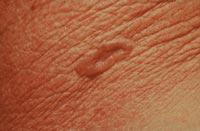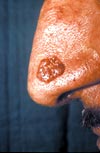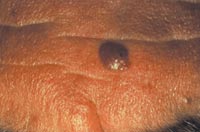

Basal cell carcinoma is the most common form of cancer worldwide. In the vast majority of cases, it is thought to be caused by exposure to the harmful ultraviolet rays of the sun. It is becoming more common, perhaps because people may be spending more time outdoors. Some believe that the decrease in the ozone layer is allowing more ultraviolet radiation from the sun to reach the earth's surface. Basal cell cancer does not usually metastasize or travel in the bloodstream; rather it infiltrates the surrounding area destroying tissue. For this reason, basal cell cancer should be treated promptly by your dermatologist with dermatologic surgical techniques.

Basal cell cancer most often appears on sun-exposed areas such as the face, scalp, ears, chest, back, and legs. These tumors can have several different forms. The most common appearance of basal cell cancer is that of a small dome-shaped bump that has a pearly white color. Blood vessels may be seen on the surface. Basal cell cancer can also appear as a pimple-like growth that heals, only to come back again and again. A less common form called morpheaform, looks like a smooth white or yellowish waxy scar. A very common sign of basal cell cancer is a sore that bleeds, heals up, only to recur again.
If you have a sore that doesn't heal, or that looks like any of the growths pictured here, you should make an appointment with your dermatologist for evaluation. After the dermatologist examines the growth, he or she will decide whether or not to perform a biopsy. A biopsy is a simple procedure done in the office under local anesthesia. The dermatologist will first inject a small amount of anesthesia similar to the type used by your dentist. After the area is numb, the dermatologist will remove a small sample of the growth or use a small cookie-cutter device to do a "punch" biopsy. A bandage will then be placed on the wound and you will receive instructions on how to care for the wound. The area will heal over five to seven days. There are several different kinds of basal cell cancer. The biopsy results will indicate whether or not you have a basal cell cancer and what kind of basal cell cancer it is. In some cases, if the basal cell cancer is very thin and present only on the surface of the skin, your dermatologist may choose to perform the biopsy and treat the skin cancer at the same time.

Your dermatologist will discuss with you the various dermatologic surgical options should your growth prove to be a basal cell cancer. Your dermatologist may use a method called electrodesiccation and curettage. In this procedure the surface of the skin cancer is removed and the base of the skin cancer is gently burned or "cauterized" with an electric needle. When this is done there is often no need for further treatment. Simple surgical excision, in which the skin cancer is cut out and the skin sewn together using dermatologic cosmetic surgical techniques will often be recommended. In this case, the specimen is examined under a microscope after the procedure to determine that all the skin cancer has been removed. Other treatment methods, such as cryosurgery, radiation therapy, and laser surgery may be used in specific circumstances. In certain situations, your dermatologist may refer you for a specialized technique called Mohs micrographically controlled surgery. In this method, performed by specially trained dermatologic surgeons, the skin cancer is removed under local anesthesia in an office setting and microscopic sections are prepared on slides while you wait. Your Mohs surgeon examines the slides to determine if most of the cancer cells have been removed. If not additional layers are taken until the cancer is completely excised. The advantage of this technique is that a minimum amount of tissue is removed and all the edges of the specimen are carefully studied. This method has a high cure rate, but is not required for all skin cancers. In general, most dermatologists agree that recurrent skin cancers, that is skin cancers that were previously treated and have come back, incompletely removed skin cancers, large skin cancers, and skin cancers in cosmetically important areas, may benefit from the Mohs technique. After the skin cancer has been removed using this method, it maybe allowed to heal naturally or reconstructive surgery using a skin flap or skin graft maybe performed.

Because the vast majority of skin cancers occur on the face, many patients are understandably concerned about the cosmetic outcome. If the skin cancer is small, conservative methods usually produce an excellent cosmetic result. If the skin cancer requires more specialized treatment such as Mohs surgery, reconstructive options are available that, in most cases, result in an excellent cosmetic outcome.

Some people wonder whether it is worth treating basal cell cancer at all since it doesn't metastasize or travel in the bloodstream to other organs. It is important to remember that basal cell cancer is in fact a cancer, and will continue to grow locally unless treated. Basal cell cancer does not spontaneously go away on its own. In addition, if the skin cancer is located near important organs such as the eyes, ears, and nose, or is growing near a nerve, serious problems can arise if the skin cancer is neglected.
If you have already had one basal cell cancer studies have shown that you are at a 40% risk of getting a second basal cell cancer within five years. It is important to follow closely with your dermatologist and be alert to any non-healing sores that develop on your skin.
Individuals who have had multiple basal cell cancers or other skin cancers, such as squamous cell, are at an increased risk for melanoma. It is important to have a full body skin examination at least once a year to check for abnormal moles which could be precursors to melanoma or melanoma itself. It is also important to know that basal cell cancer does not turn into melanoma.
Because basal cell cancer is caused by ultraviolet radiation from the sun in the vast majority of cases, proper sun protection may help to prevent the development of further basal cell cancers. Because 85% of lifetime sun exposure is acquired in childhood by age 18, careful sun protection in children may effectively prevent basal cell cancer later in life. Follow these simple steps from your dermatologist and dermatologic surgeon: 1. Apply sunscreen with a sun protection factor of 15 or greater while outdoors 2. Wear a broad-brimmed hat and sun protective clothing 3. Avoid the sun between 10:00 a.m. and 4:00 p.m.
Many people wonder how often they have to reapply sunscreen. In general, if you are active outdoors, it is quite reasonable to apply sunscreen every 1 1/2 hours. As long as you practice good sun protection habits and enjoy the sun in moderate amounts you should be able to minimize the chances of developing basal cell cancer.

